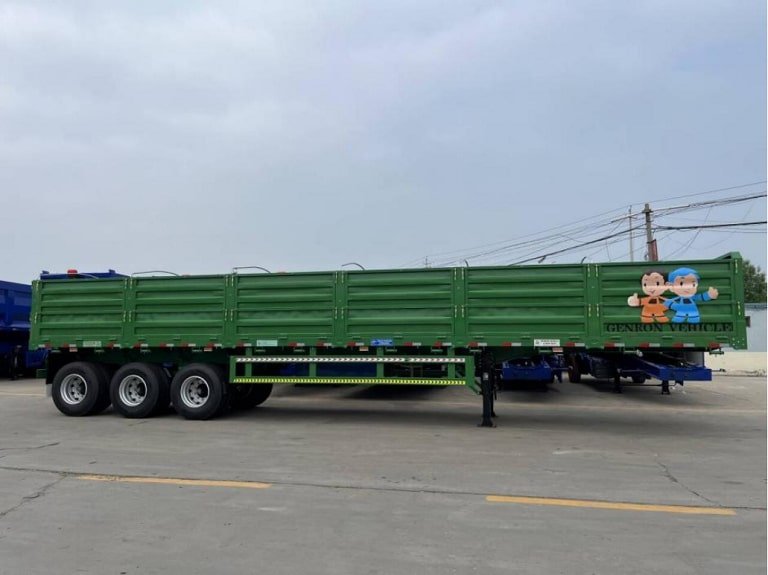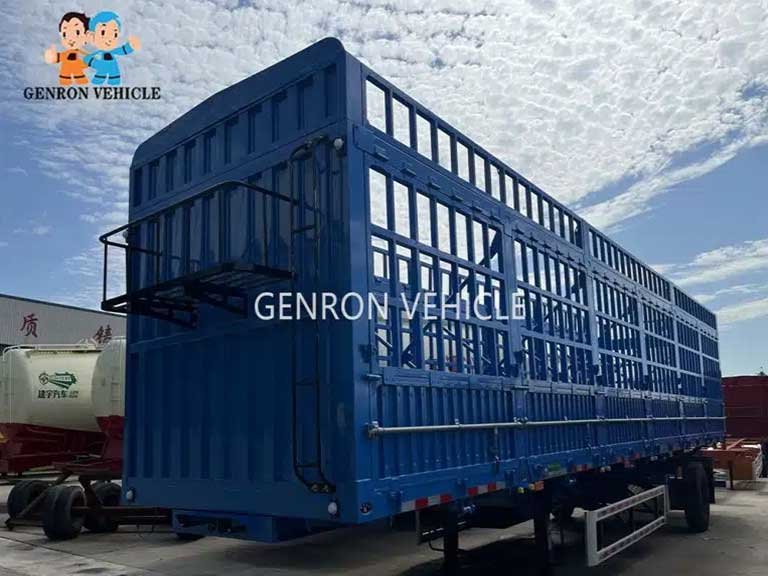In the transportation industry, sidewall semi-trailers are the tool of choice for many companies because of their versatility and protection. Whether you’re hauling bulk materials, large pieces of equipment, or cargo that needs partial protection, choosing the right size sidewall semi-trailer is critical to securing your cargo, improving transportation efficiency, and complying with local regulations. By understanding the standard sizes of different types of sidewall semi-trailers and the factors that influence them, companies can make more informed decisions to optimize their transportation processes and reduce operating costs. In this article, Genron takes an in-depth look at standard sidewall semitrailer dimensions and their impact on transportation operations, as well as providing practical advice on how to choose the right size.
Table of Contents
Table of Contents
Standard Sidewall Semitrailer Dimensions
Sidewall semi-trailer dimensions typically vary depending on their use and required load carrying capacity. Below are some common standard dimensions:
- Length: Standard sidewall semi-trailers are usually between 12 and 15 meters in length, depending on the design and use of the trailer. For example, 40-foot (about 12 meters) and 45-foot (about 13.7 meters) sidewall semi-trailers are the most common sizes and are suitable for a variety of transportation needs. Longer trailers are able to carry more cargo, but may be limited when operating on city streets or in tight areas.
- Width: Standard sidewall semi-trailers are typically 2.5 meters wide, a size that is widely available worldwide and complies with road transportation regulations in most countries and regions. Wider trailers, while providing more loading space, may be limited by road width in some areas, so the specifics of the transportation route should be taken into account when selecting the width.
- Height: The height of the sidewalls usually ranges between 1.5 and 2 meters. This height range provides adequate protection for most cargoes while maintaining good ease of loading and unloading. Higher sidewalls are suitable for transporting goods of greater height, while lower sidewalls are suitable for materials that do not require much protection.
Begin with a bespoke semi-trailer designed for your exact needs. Whether it’s heavy-duty hauling or specialized cargo, we’ve got the perfect solution to keep you moving forward.
Dimensions of Different Types of Sidewall Semi-trailers
Sidewall semi-trailers vary in size according to different uses and transportation needs. Below are a few common types of sidewall semi-trailers and their dimensional characteristics:
Heavy Duty Sidewall Semi-Trailer
Heavy-duty sidewall semi-trailers are usually designed to transport heavy or extra-heavy cargo, such as construction materials, large equipment, and so on. The sidewalls of these trailers are usually higher and thicker to provide extra strength and protection. Heavy-duty sidewall semi-trailers tend to be the same length and width as standard trailers, but are significantly taller and have stronger sidewalls to cope with the demands of transporting heavy loads.
Long-haul sidewall semitrailers
Long haul sidewall semi-trailers are usually designed to provide better stability and efficiency in long haul transportation. These trailers may be longer in length, with sidewall heights depending on the type of cargo. Long haul trailers are usually more durable and able to handle long hauls, ensuring the safety of the cargo over long distances.
Customized Sidewall Semi-Trailers
Genron’s customized sidewall semi-trailers are designed to meet the specific needs of the customer and can be adjusted in length, width and height to meet specific transportation tasks. Whether it’s to accommodate a specially sized load or to cope with a specific transportation environment, customized sidewall semi-trailers offer great flexibility and utility.

Factors influencing the size of sidewall semi-trailers
Choosing the right size of sidewall semi-trailer requires consideration of a number of factors that will have a direct impact on the trailer’s performance and transportation results:
Cargo type
Different types of cargo require different sizes of sidewall semi-trailers. For example, transporting large equipment or heavy construction materials may require higher or wider sidewalls to ensure the stability and safety of the cargo. For bulk materials or goods that require partial protection, such as agricultural products, a moderate sidewall height and length may be required.
Transportation routes
The complexity of transportation routes and road conditions can also affect the choice of sidewall semitrailer size. On urban or narrow roads, a shorter, narrower trailer may be easier to maneuver and turn, while on open highways, a longer trailer will increase efficiency and reduce the number of round trips.
Regulatory requirements
Countries and regions have different regulatory restrictions on trailer size. For example, in the European Union, the maximum width of a sidewall semi-trailer is usually 2.55 meters, while wider trailers may be allowed in North America. To ensure compliance with local regulations, such as the EU Road Traffic Safety Act and the US Federal Highway Safety Standards (FHWA), these should be fully understood and adhered to when choosing a trailer size.

Advice on choosing the right size sidewall semi-trailer
Choosing the right size of sidewall semi-trailer according to specific needs can significantly improve transportation efficiency and safety:
Selection according to cargo
When selecting a sidewall semi-trailer, Genron recommends first considering the type and size of the cargo being transported. Larger cargoes may require taller sidewalls and longer cabins, while smaller cargoes may fit on a standard-sized trailer. Knowing the weight and volume of the cargo will help in selecting the most appropriate trailer size.
Consider the operating environment
Different transportation environments require different trailer sizes. For example, in urban transportation, shorter trailers are easier to operate, while in long-distance transportation, longer trailers can carry more cargo and reduce the number of trips. Considering the transportation routes and operating environments helps to select the most suitable trailer size.
Customization
If the standard size sidewall semi-trailer cannot meet the demand, customization service is a good choice. Depending on the specific transport task, customized sidewall semi-trailers can be adjusted in length, width, and height to ensure optimal transportation. Whether it’s for transporting a special size of cargo or for dealing with a specific transport environment, customized sidewall semi-trailers can provide the best solution.

Conclusion
Choosing the right size of sidewall semi-trailer is essential to ensure cargo safety and improve transportation efficiency. When choosing one, it is important to consider the type of cargo, transportation routes, and regulatory requirements to ensure that the trailer you select meets your transportation needs and complies with local regulations. At Genron International Trade, we offer a wide range of standard and customized sidewall semi-trailers to meet the needs of different customers. Whether it’s a standard, heavy-duty or custom trailer, we are committed to providing our customers with the highest quality products and services to help you optimize every transportation task.
FAQs
What are the dimensions of a standard sidewall semi-trailer?
The length of a standard sidewall semi-trailer is usually between 12 and 15 meters, the width is 2.5 meters, and the height is 1.5 to 2 meters.
How to choose the size of a sidewall semi-trailer according to the cargo?
Choose the appropriate sidewall height and carriage length according to the size and weight of the cargo. For example, heavy cargoes may require higher sidewalls and stronger structures.
Do sidewall semitrailer dimensions vary from region to region?
Yes, each country and region has different regulatory restrictions on the size of sidewall semi-trailers, so be sure to comply with local regulations when selecting one.
What do I need to pay attention to when customizing a sidewall semi-trailer?
When customizing a sidewall semi-trailer, you need to consider the specific needs of the transport task and ensure that the selected dimensions comply with the requirements of the transport route and local regulations.


